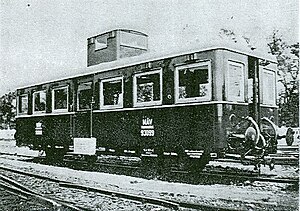ČSD series M 130.3
| ČSD series M 130.3 | |
|---|---|
| Numbering: | M 130.301-330 |
| Number: | 30th |
| Manufacturer: | Tatra Mountains Kopřivnice |
| Year of construction (s): | 1933-1937 |
| Retirement: | around 1950 |
| Axis formula : | 1A |
| Gauge : | 1435 mm ( standard gauge ) |
| Length over buffers: | 01-10: 10,610 mm 11-30: 10,700 mm |
| Total wheelbase: | 01-10: 4800 mm 11-30: 5,000 mm |
| Smallest bef. Radius: | 180 m |
| Empty mass: | 01-10: 12.62 t 11-20: 15.36 t 21-30: 15.6 t |
| Service mass: | 01-10: 16 t 11-20: 19.36 t 21-30: 19.5 t |
| Friction mass: | 8.2 t |
| Top speed: | 60 km / h |
| Installed capacity: | 01-10: 120 hp 11-30: 125 hp |
| Driving wheel diameter: | 880 mm |
| Wheel diameter: | 880 mm |
| Motor type: | Tatra Mountains |
| Motor type: | 6 cylinder diesel engine |
| Rated speed: | 1400 rpm |
| Power transmission: | mechanically |
| Tank capacity: | 280 l |
| Brake: | Traction brake system KNORR |
| Seats: | 37 |
The vehicles of the ČSD series M 130.3 were two-axle diesel multiple units for regional traffic of the former Czechoslovak State Railways (ČSD). The vehicles conceptually corresponded to the ČSD series M 130.2 , they received a diesel engine instead of the gasoline engine .
history
At Tatra in Kopřivnice , a total of 30 two-axle railcars with a length of 10,610 mm and one engine were produced in three series from 1933 to 1937. The basic shape and the external appearance of the railcar correspond to the vehicles M 120.3 , M 120.4 and M 130.2 manufactured by Tatra .
technical features
The railcar was powered by a 6-cylinder, 4-stroke Tatra diesel engine. The power was initially 120 hp. In subsequent deliveries, it could be increased to 125 hp, which at the same time brought a change in external parameters such as wheelbase, mass and number of seats. In this series, a reversing gear was used for the first time to change the direction of travel.
As in the previous models, the mechanical power transmission was realized with a planetary gear from Tatra. The specified technical data relate to the first series.
Other features of the car, such as the heating of the compartment or braking devices, are the same as the previous models.
commitment
Together with the other types of tower railcars, the vehicles made up almost half of the number of motorized railcars on the numerous ČSD local railways. They were originally painted dark gray-green up to the parapet and pea green between and above the windows. Due to an expert opinion for the safety of rail traffic with the frequent crossings and the increasing car traffic, this paint was later changed to dark red. Vehicles that were taken over by the Reichsbahn after 1938 were given the same railcar paint scheme.
The vehicles proved their worth and provided service on local railways until the mid-1950s when they were replaced by the new M 131.1 class railcars . The M 130.323 is a specialty. With several M 130.2 railcars it was handed over to MAV in 1938 and served there with the Budapesti Helyi Érdekü Vasutak , BHÉV . The photograph was taken when the vehicle was handed over in 1938. The sign on the entrance door confirms this. In 1951 the vehicle was taken out of service and converted into a sidecar (with a tower) in 1954. The vehicle served this way for several years. In 2007 a photograph shows the railcar parked in a desperate condition in Budapest.
A vehicle from the M 130.3 series has not been preserved in a museum.
See also
literature
- Bek Jindrich, Janata Josef, Veverka Jaroslav: Malý atlas lokomotiv 2, Elektrická a motorová trakce, Nadas Publishing House Prague
- Istvan Lovacz: Motory Vozu M 130.323 Železničář magazine, volume 1987 number 15
Web links
- Photograph of the front of the M 130.314 on k-report.net
- Photograph of the driver's cab of the M 130.314 on k-report.net
Individual evidence
- ↑ Bek Jindrich, Janata Josef, Veverka Jaroslav: Malý atlas lokomotiv 2, Elektrická a motorová trakce, Nadas-Verlag Prague, 1969
- ↑ photograph of the M 130,323 to www.k-report.net from the 1990s
- ↑ Discussions about M 130.323 on www.k-report.net

